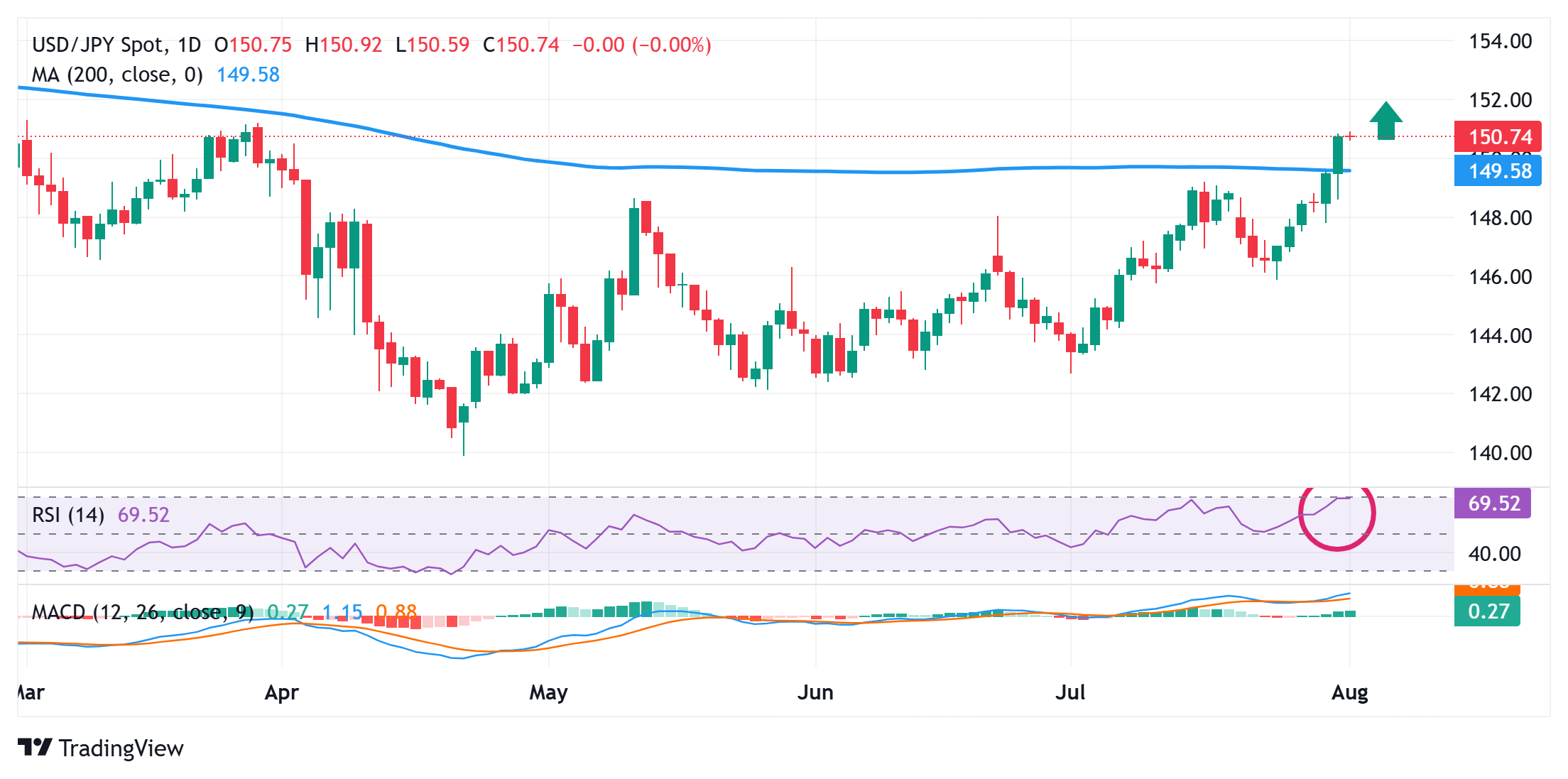Created
: 2025.08.01














![]() 2025.08.01 11:50
2025.08.01 11:50
The Japanese Yen (JPY) touches a fresh four-month low against its American counterpart during the Asian session on Friday and seems vulnerable to weaken further. The Bank of Japan (BoJ) revised up its inflation forecasts on Thursday and offered a less gloomy outlook on the economy, keeping hopes alive for the resumption of rate hikes later this year. However, BoJ Governor Kazuo Ueda struck a dovish tone and signaled patience in policy normalization, to observe the tariff impact after the US-Japan trade deal. Furthermore, domestic political uncertainty, which has been fueling concerns about Japan's fiscal health, continues to undermine the JPY.
Meanwhile, the global risk sentiment takes a hit after US President Donald Trump signs an executive order imposing higher tariffs of up to 41% on key trading partners across the globe. This offers some support to traditional safe-haven assets and helps limit JPY losses. The US Dollar (USD), on the other hand, is seen consolidating its strong weekly gains to its highest level since late May, bolstered by the slightly more hawkish-than-expected Federal Reserve (Fed), and contributes to capping the USD/JPY pair. Traders also seem reluctant and opt to wait for the release of the US Nonfarm Payrolls (NFP) report before placing fresh directional bets.

The overnight sustained breakout through the very important 200-day Simple Moving Average (SMA) and the subsequent strength beyond the 150.00 psychological mark was seen as a fresh trigger for the USD/JPY bulls. However, the daily Relative Strength Index (RSI) is on the verge of breaking into overbought territory, suggesting that spot price could pause the positive move at the March swing high, around the 151.20 region. Nevertheless, the broader setup backs the case for an extension of the recent well-established uptrend.
Hence, any corrective pullback towards the 150.00 round figure might be seen as a buying opportunity. This, in turn, should help limit the downside for the USD/JPY pair near the 149.55 region (200-day SMA). The latter should act as a strong near-term base for spot prices, which, if broken decisively, could prompt some technical selling and expose the next relevant support near the 149.00 mark.
The Japanese Yen (JPY) is one of the world's most traded currencies. Its value is broadly determined by the performance of the Japanese economy, but more specifically by the Bank of Japan's policy, the differential between Japanese and US bond yields, or risk sentiment among traders, among other factors.
One of the Bank of Japan's mandates is currency control, so its moves are key for the Yen. The BoJ has directly intervened in currency markets sometimes, generally to lower the value of the Yen, although it refrains from doing it often due to political concerns of its main trading partners. The BoJ ultra-loose monetary policy between 2013 and 2024 caused the Yen to depreciate against its main currency peers due to an increasing policy divergence between the Bank of Japan and other main central banks. More recently, the gradually unwinding of this ultra-loose policy has given some support to the Yen.
Over the last decade, the BoJ's stance of sticking to ultra-loose monetary policy has led to a widening policy divergence with other central banks, particularly with the US Federal Reserve. This supported a widening of the differential between the 10-year US and Japanese bonds, which favored the US Dollar against the Japanese Yen. The BoJ decision in 2024 to gradually abandon the ultra-loose policy, coupled with interest-rate cuts in other major central banks, is narrowing this differential.
The Japanese Yen is often seen as a safe-haven investment. This means that in times of market stress, investors are more likely to put their money in the Japanese currency due to its supposed reliability and stability. Turbulent times are likely to strengthen the Yen's value against other currencies seen as more risky to invest in.
![]()
Created
: 2025.08.01
![]()
Last updated
: 2025.08.01

FXStreet is a forex information website, delivering market analysis and news articles 24/7.
It features a number of articles contributed by well-known analysts, in addition to the ones by its editorial team.
Founded in 2000 by Francesc Riverola, a Spanish economist, it has grown to become a world-renowned information website.
We hope you find this article useful. Any comments or suggestions will be greatly appreciated.
We are also looking for writers with extensive experience in forex and crypto to join us.
please contact us at [email protected].
Disclaimer:
All information and content provided on this website is provided for informational purposes only and is not intended to solicit any investment. Although all efforts are made in order to ensure that the information is correct, no guarantee is provided for the accuracy of any content on this website. Any decision made shall be the responsibility of the investor and Myforex does not take any responsibility whatsoever regarding the use of any information provided herein.
The content provided on this website belongs to Myforex and, where stated, the relevant licensors. All rights are reserved by Myforex and the relevant licensors, and no content of this website, whether in full or in part, shall be copied or displayed elsewhere without the explicit written permission of the relevant copyright holder. If you wish to use any part of the content provided on this website, please ensure that you contact Myforex.
Myforex uses cookies to improve the convenience and functionality of this website. This website may include cookies not only by us but also by third parties (advertisers, log analysts, etc.) for the purpose of tracking the activities of users. Cookie policy